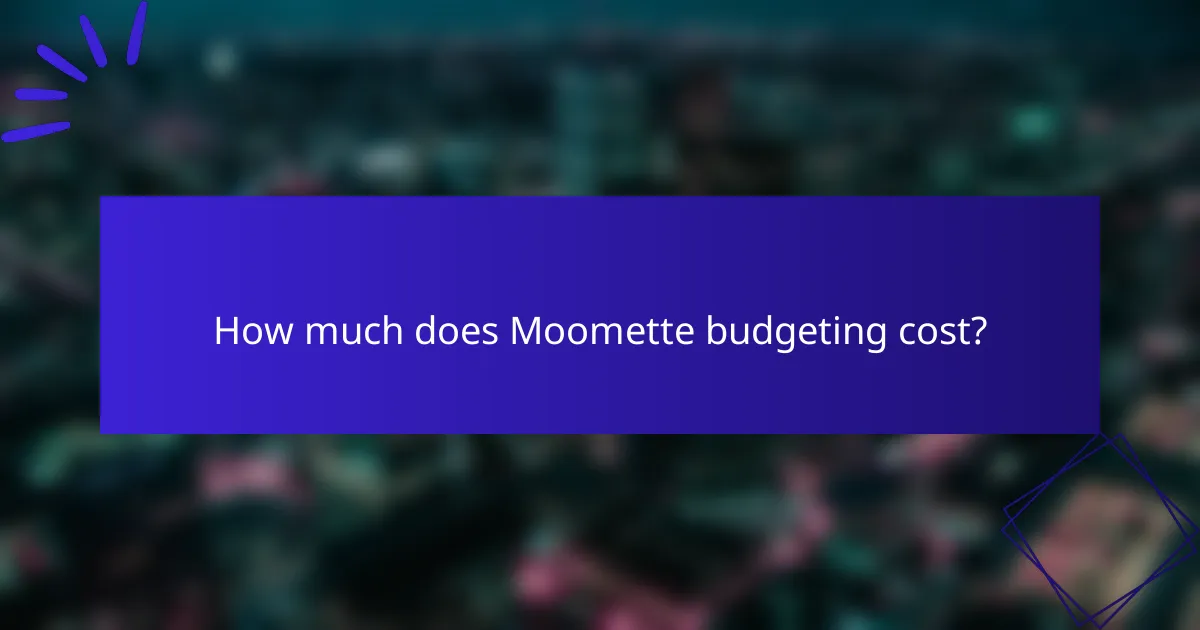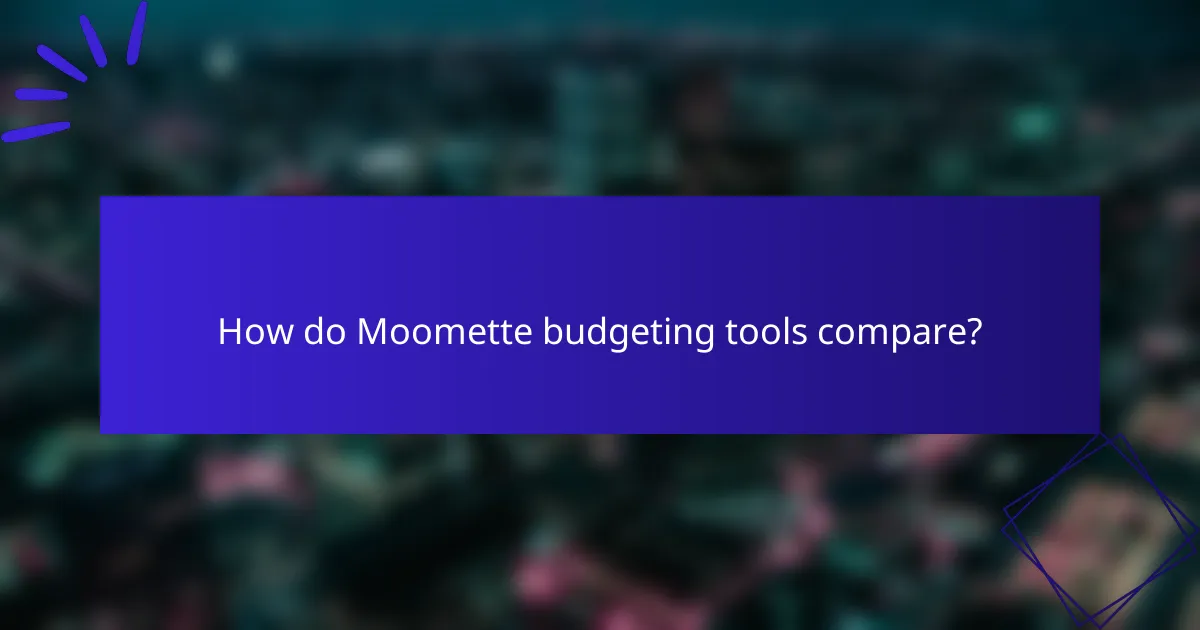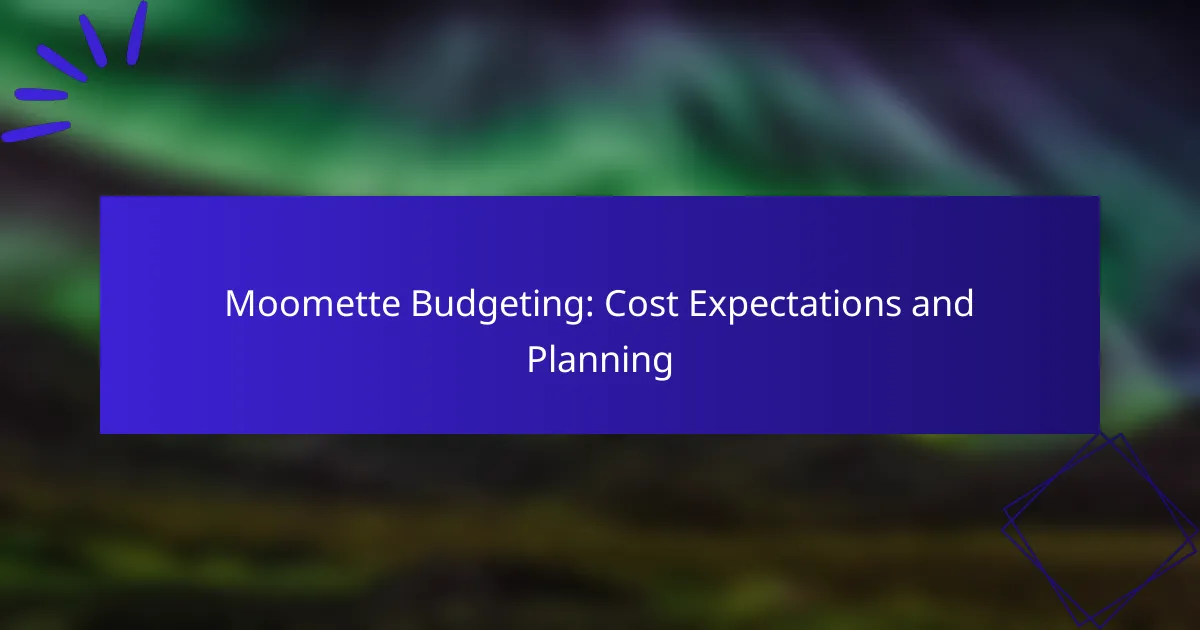Moomette offers a range of budgeting solutions designed to meet diverse financial planning needs, including monthly templates and expense tracking apps. By understanding the associated costs, such as subscription fees and potential service charges, users can effectively plan their budgets and avoid surprises. With features like customizable categories and real-time tracking, Moomette empowers users to manage their finances with ease.

What are the budgeting solutions for Moomette users?
Moomette users can access various budgeting solutions tailored to their financial planning needs. These include monthly budgeting templates, expense tracking apps, and financial planning services that help users manage their finances effectively.
Monthly budgeting templates
Monthly budgeting templates provide a structured way for Moomette users to plan their expenses and income. These templates typically include sections for fixed costs like rent and variable expenses such as groceries, allowing users to visualize their financial situation.
When using a budgeting template, it’s essential to categorize expenses accurately and update the template regularly. Users can find free templates online or create their own using spreadsheet software, ensuring they fit their specific financial goals.
Expense tracking apps
Expense tracking apps enable Moomette users to monitor their spending in real-time. These apps often sync with bank accounts and credit cards, automatically categorizing transactions and providing insights into spending habits.
Popular apps include Mint, YNAB (You Need A Budget), and PocketGuard. Users should consider features like user-friendliness, cost (many are free or have low subscription fees), and compatibility with their financial institutions when choosing an app.
Financial planning services
Financial planning services offer personalized advice and strategies for Moomette users looking to achieve long-term financial goals. These services can range from one-time consultations to ongoing support, depending on user needs.
When selecting a financial planner, users should look for certified professionals with experience in budgeting and investment strategies. Fees can vary widely, so it’s advisable to compare services and understand the fee structure before committing.

How much does Moomette budgeting cost?
Moomette budgeting typically involves a combination of monthly subscription fees, one-time setup costs, and potential additional service fees. Understanding these costs can help you plan your budget effectively and avoid unexpected expenses.
Average monthly subscription fees
The average monthly subscription fees for Moomette budgeting services usually range from $10 to $30, depending on the features offered. Basic plans often include essential budgeting tools, while premium plans may provide advanced features like financial analytics and personalized coaching.
When selecting a subscription, consider your specific needs and how frequently you plan to use the service. Some providers offer discounts for annual payments, which can be a cost-effective option if you are committed long-term.
One-time setup costs
One-time setup costs for Moomette budgeting can vary widely, typically falling between $50 and $200. These fees may cover initial consultations, personalized financial assessments, or the setup of your budgeting system.
Before committing, inquire about what the setup fee includes. Some services may offer free trials or reduced fees for first-time users, which can help you gauge the service’s value without a significant upfront investment.
Additional service fees
Additional service fees may apply for features such as financial coaching, advanced reporting, or integration with other financial tools. These fees can range from $5 to $50 per session or feature, depending on the provider.
To avoid surprises, carefully review the pricing structure and any potential add-ons before signing up. Look for services that clearly outline their fees and provide options for customizing your plan based on your budgeting needs.

What are the key features of Moomette budgeting tools?
Moomette budgeting tools offer essential features that help users manage their finances effectively. Key functionalities include customizable budget categories, real-time expense tracking, and seamless integration with bank accounts, all designed to enhance financial planning.
Customizable budget categories
Moomette allows users to create and modify budget categories according to their specific financial needs. This flexibility enables individuals to allocate funds for various expenses such as groceries, utilities, and entertainment, tailoring their budget to reflect personal priorities.
When setting up categories, consider using broad headings like “Housing” or “Transportation” and then breaking them down into subcategories. This approach provides clarity and helps in tracking spending more accurately.
Real-time expense tracking
The real-time expense tracking feature in Moomette ensures that users can monitor their spending as it occurs. This immediacy helps in maintaining awareness of financial habits and allows for timely adjustments to the budget.
To maximize this feature, regularly input expenses or link the tool to your bank accounts. This practice can prevent overspending and promote better financial discipline.
Integration with bank accounts
Moomette’s integration with bank accounts simplifies the budgeting process by automatically importing transactions. This feature reduces manual entry, saving time and minimizing errors in tracking expenses.
When setting up bank integration, ensure that you choose secure connections and regularly review the imported data for accuracy. This vigilance helps maintain a clear picture of your financial status and supports effective budgeting.

How do Moomette budgeting tools compare?
Moomette budgeting tools vary in features, usability, and pricing, making it essential to evaluate them based on your specific financial needs. Key factors include ease of use, integration with bank accounts, and the types of reports generated.
Comparison of popular budgeting apps
Popular budgeting apps like Mint, YNAB (You Need A Budget), and PocketGuard each offer unique features. Mint is known for its comprehensive financial tracking and free access, while YNAB focuses on proactive budgeting strategies, requiring a subscription. PocketGuard simplifies budgeting by showing how much disposable income you have after bills and goals.
When comparing these tools, consider how each app aligns with your financial habits. For instance, if you prefer a hands-on approach, YNAB might suit you better, while Mint may be ideal for those who want automatic tracking.
Pros and cons of each tool
Mint’s strengths lie in its free service and extensive financial insights, but it may lack the personalized guidance some users need. YNAB offers robust budgeting techniques and community support, yet it comes with a monthly fee that some may find prohibitive.
PocketGuard’s main advantage is its straightforward interface and real-time spending alerts, but it may not provide as detailed a financial overview as Mint or YNAB. Weighing these pros and cons can help you choose the right tool for your budgeting style.
User reviews and ratings
User reviews highlight that Mint is praised for its user-friendly interface but criticized for occasional syncing issues with bank accounts. YNAB users often commend its educational resources and community support, although some mention the learning curve associated with its budgeting philosophy.
PocketGuard generally receives positive feedback for its simplicity and effectiveness in managing day-to-day expenses. Ratings across platforms typically range from 4 to 4.5 stars, indicating a solid user satisfaction level, but individual experiences can vary based on personal financial habits.

What are the prerequisites for effective Moomette budgeting?
Effective Moomette budgeting requires a solid understanding of personal finance, clear financial goals, and organized financial documents. These prerequisites help individuals create a realistic budget that aligns with their income and expenses.
Understanding personal finance basics
Grasping personal finance basics is crucial for Moomette budgeting. This includes knowledge of income sources, fixed and variable expenses, and the importance of saving. Familiarity with concepts like cash flow and debt management can significantly enhance budgeting efforts.
Consider using budgeting methods such as the 50/30/20 rule, which allocates 50% of income to needs, 30% to wants, and 20% to savings and debt repayment. This framework provides a straightforward approach to managing finances effectively.
Setting financial goals
Setting clear financial goals is essential for guiding your Moomette budgeting process. Goals should be specific, measurable, achievable, relevant, and time-bound (SMART). For example, aiming to save a certain amount for a vacation within a year can motivate disciplined spending.
Prioritize your goals by distinguishing between short-term and long-term objectives. Short-term goals might include saving for an emergency fund, while long-term goals could involve retirement savings or purchasing a home. This prioritization helps allocate resources more effectively.
Gathering financial documents
Collecting relevant financial documents is a key step in Moomette budgeting. This includes pay stubs, bank statements, bills, and tax returns. Having these documents organized allows for accurate tracking of income and expenses.
Consider creating a financial binder or digital folder to keep all documents in one place. Regularly updating this information ensures that your budget reflects your current financial situation, making it easier to adjust as needed.

What are the common mistakes in Moomette budgeting?
Common mistakes in Moomette budgeting include underestimating expenses and neglecting irregular costs. These errors can lead to financial shortfalls and hinder effective planning.
Underestimating expenses
Underestimating expenses is a frequent pitfall in Moomette budgeting. Many individuals fail to account for all necessary costs, often leading to a budget that appears balanced but is unrealistic. It’s crucial to include all fixed and variable expenses, such as rent, utilities, groceries, and transportation.
A practical approach is to track spending over a few months to identify typical expenses. This helps create a more accurate budget that reflects true financial needs. Aim to overestimate slightly to create a buffer for unexpected costs.
Neglecting irregular costs
Neglecting irregular costs can significantly impact Moomette budgeting. These costs, such as annual insurance premiums, car maintenance, or holiday gifts, may not occur monthly but can add up quickly when they do. Failing to plan for these expenses can disrupt cash flow.
To manage irregular costs effectively, consider creating a separate savings fund. Allocate a small amount each month to cover these expenses when they arise. This proactive strategy ensures that your budget remains intact and reduces the risk of financial strain during peak spending periods.
